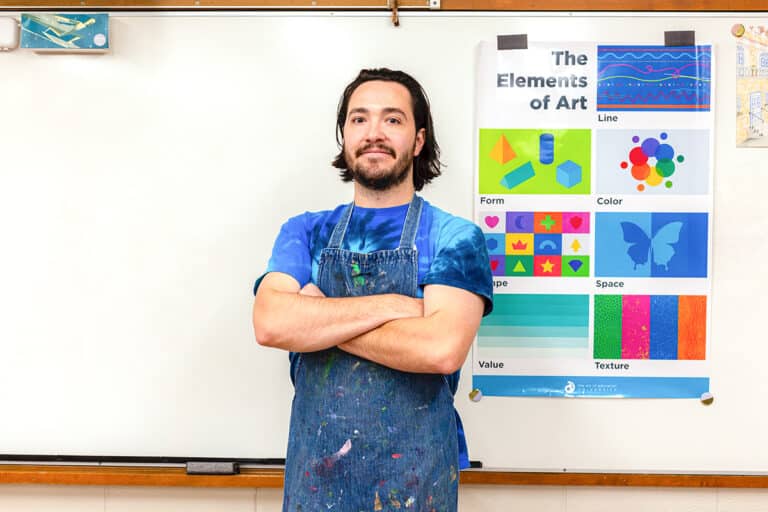Do you remember taking on an internship while in high school? Pre-college internships are growing in popularity, which is excellent news for the art classroom! An art room internship provides students with creative leadership opportunities, practical experience, and, often, academic credit. Kaleb Rashad, the interim CEO of High Tech High Schools in San Diego, CA, explains, “Internships are rich learning opportunities for students and community partners. They don’t just go to work—students document their experiences through photo-essays, blogs, and presentations of learning.”
Keep reading to learn how to navigate the internship process from start to finish, including six ways to set everything up for success!

Consider a High School Intern
Ultimately, an internship helps guide students’ college and career choices after graduation. U.S. News and World Report noted that, unlike college internships, “high school internships focus more on experience and learning than on obtaining full-time work.” From managing groups to giving constructive feedback, the skill sets they gain are transferable to the real world and in areas of public service.
You, their mentor teacher, also benefit from this relationship. Interns can share a fresh viewpoint, innovative ideas for lessons, and suggestions for interacting with students. They can help you complete tasks, work with small groups, and fulfill needs in the art room. So, how do you find a high school intern and develop meaningful work for them?
Connect With an Intern
Many high school programs require students to complete an internship to graduate. In some districts, internship coordinators reach out to local school directors to ask if educators are interested in mentoring. With permission from your site director, consider reaching out to your district’s internship coordinator. Ask if they maintain a list of internship sites to which you can add your name.
It is also possible to seek out an intern by posting on job boards or your school site’s careers page. You can ask for referrals from friends and family and use platforms specific to internships. Before posting or working with outside agencies, check with your school or district to understand the requirements associated with internships and mentoring programs.

Interview Intern Candidates
Ideally, you will have an opportunity to meet your internship candidates face-to-face for your interviews. However, video conference calls are a great option if there are time or travel concerns. This is also an opportunity for the candidates to ask questions about the internship.
Here are ten questions you can ask to guide the interview:
- Why do you want this position?
- Tell me about your prior art experience.
- Why is art important for students to learn?
- Describe a time you felt supported by a teacher or staff member at school.
- How would you handle the situation if I was trying to get the class started and a student was interested in continuing a conversation with you?
- What skills can you contribute to the art room and internship?
- What skills do you hope to gain from this experience?
- Share one of your best memories of art class and why it stands out to you.
- How did you overcome a recent challenging project or assignment?
- What questions do you have for me?
Develop Meaningful Work
The art room internship serves both the intern and the art classroom. Meaningful work occurs through dialogue, original thinking, and the intern’s agency regarding their shared interest in the class. It’s essential to build rapport with your high school intern, as they are still adolescents. As they balance their obligations as a student and the standards of the professional world through their internship, they will need support navigating this new leadership position.
Let’s look at six ways to set the internship up for success as you develop meaningful work.

1. Define responsibilities.
Teaching and guiding the intern is a time and communication commitment. The intern and mentor must discuss the intern’s progress. You must also communicate expectations in the ever-changing environment of the art room. Clear expectations and defined responsibilities will result in smoother communication. Before setting goals, take time to clearly define both the mentor and intern’s responsibilities.
Mentor Teacher’s Responsibilities:
- Interview intern candidates
- Provide supervision and guidance
- Document the intern’s progress
- Act as a point person between the intern and their school
- Allow or encourage the intern to attend staff meetings
- Assign tasks and manage them through completion
- Evaluate the intern’s strengths and weaknesses
Intern’s Responsibilities:
- Interview with the mentor teacher
- Complete paperwork as required by their school
- Design and complete a project to benefit the host organization
- Take the initiative to volunteer for tasks
- Communicate with the mentor teacher by asking questions and clarifying expectations
- Document the internship experience
- Create artifacts to demonstrate growth
- Present learning
Tasks Interns Can Take On:
- Inventory supplies
- Assist with supply management and distribution
- Connect with students about their work by offering encouragement, ideas, and feedback
- Share a portfolio presentation of their artwork
- Support small group work
- Complete tasks on the mentor’s to-do list
2. Set clear goals through shared purpose.
How will the internship experience benefit the host organization (your school) and deepen the intern’s learning? Goal setting should play to the intern’s strengths. It can also support areas where they seek to grow while also fulfilling a need in your art program. Investigate their strengths based on their interview responses. Is there anything that stood out that can be applied to a project or task needed in your classroom?
Here is an example scenario:
In the interview, perhaps the intern mentioned they had prior art experience painting commissioned murals. They enjoy painting murals and feel confident about teaching others the steps to plan a mural. The creation of a legacy project is on your year-end to-do list, and you think a mural is a fantastic way to accomplish this. One area the intern expressed needing support in is managing students.
Some of their goals may look something like this:
- Propose ideas and poll students for input on the theme of the mural.
- Work with the mentor teacher to divide students into small groups and assign roles.
- Write out the steps and timeline for the planning and creation of the mural.
- Conference with the mentor teacher to review the plan and anticipate any challenges.
3. Ensure the work is authentic.
Once the goals are established, it’s crucial to ensure the intern’s work is authentic. You may be wondering what authentic work is. Learning innovations site Getting Smart states, “One of the best ways for learning to be authentic is to use real-world problems, challenges, and questions as the primary pursuit.” Additionally, authentic work relates to expressing your personality, feeling safe, and being valued for being you. Part of the internship experience is allowing them to find their way. Make sure they contribute to the discussion, take ownership of the project, and have the opportunity to apply what they know.
In our legacy mural scenario, authentic work is demonstrated when the intern:
- Supports the mentor by taking on the real-world problem of the year-end task.
- Develops a plan to execute a mural painting project that interests them and anticipates challenges.
- Learns how to manage groups by asking the mentor questions.
4. Uphold professional standards.
For high school interns, this may be the first time they are venturing into the world of professional expectations. Showing up on time, dressing appropriately, and shifting into a leadership role may be new experiences. High school interns must also be differentiated from the students in your classroom. How they perceive themselves and how the class perceives them must have defined boundaries. For instance, the intern may need access to their phone or computer at times when it would be inappropriate for the class to do so. As their mentor, you will guide these expectations through communication and modeling.
5. Provide detailed and specific feedback and evaluations.
To monitor growth and maximize the internship experience, regular communication is essential. Open lines of communication early on to prepare the intern for their final evaluation. Schedule time for a quick chat each day. This can be a morning check-in, a “download of the day,” or ideas for the future. Additionally, plan to connect weekly for thirty minutes or more for deeper discussions.
Your intern’s insight is valuable because the lens they view the students through is not of a fully independent adult. We see things as a professional that they will miss. They see things more closely aligned with how a student would see and process things. They are more attuned to the social dynamics in the classroom than we may be.
On-going feedback allows the intern to:
- Implement real-time adjustments in the fluid environment of the art room.
- Ensure they receive the resources they need in a timely fashion.
- Support pacing and adhere to a timeline.
- Course correct if something isn’t working.
There should be no surprises when it comes to time for the final evaluation. Share the evaluation tool early on. You can share it around the same time as goal setting or when introducing expectations. According to Chegg Internships, it’s best to provide a written evaluation. Formal documentation serves as a record and is retained better than oral communication.
6. Require a presentation of learning.
Internships usually culminate in a presentation of learning. Whether a portfolio of work, a panel discussion, or sharing a blog, it’s an essential step in processing their experience and documenting their growth. Their final presentation should encompass their project-building process, not just a demonstration of the product they create.
Here are some questions interns can consider including in their final presentation:
- What are you most proud of about this internship?
- Describe a time when you encountered a challenge. How did you overcome it?
- What was the process for arriving at the final product?
- What skill sets have you developed that will carry you beyond this internship?
- How is the work you completed relevant to the real world?
- What would you change if you could start the internship over?

Make the Connection!
Hosting a high school intern in the art classroom is a win-win situation. If this idea is new to you, reach out and connect with your school or district to learn about mentorship programs. While this is often an intern’s first exposure to the working world, it’s an undeniably important career-training opportunity. The intern benefits from solving real-world problems and gaining experience in a field of interest. The mentor teacher benefits from a second set of eyes, hands, and ideas while fulfilling needs in the classroom. Connecting with a high school intern is supportive of both of your goals. Don’t wait and give an internship a try this year!
Have you ever worked with an art room intern?
What advice would you give to a first-time mentor teacher?
Magazine articles and podcasts are opinions of professional education contributors and do not necessarily represent the position of the Art of Education University (AOEU) or its academic offerings. Contributors use terms in the way they are most often talked about in the scope of their educational experiences.






